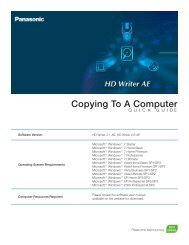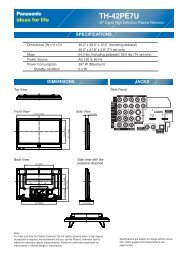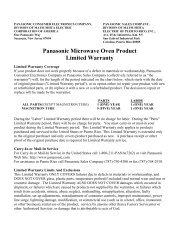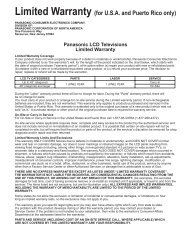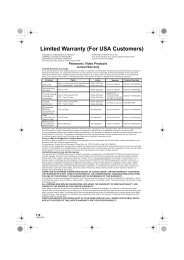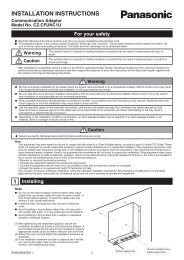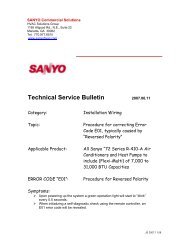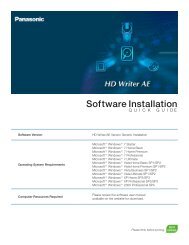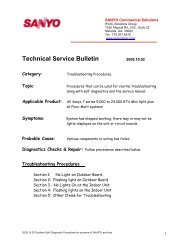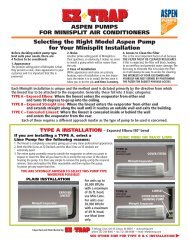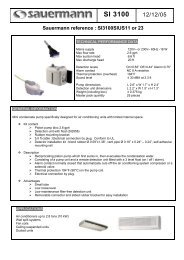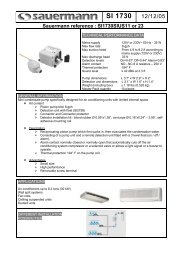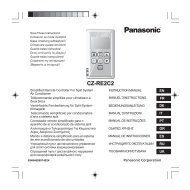"Tech Tips" RAC/PAC - Panasonic
"Tech Tips" RAC/PAC - Panasonic
"Tech Tips" RAC/PAC - Panasonic
Create successful ePaper yourself
Turn your PDF publications into a flip-book with our unique Google optimized e-Paper software.
<strong>Tech</strong>nical Tips<br />
<strong>RAC</strong>/<strong>PAC</strong><br />
1
Table of contents<br />
Page 3 Check list before you call<br />
Page 4 Inverter technology<br />
Page 5 26 thru 42k Btu units dual wiring diagram<br />
Page 6 9 thru 24k Btu units wiring diagram<br />
Page 7 Flexi Multi wiring diagram<br />
Page 8 Trouble shooting for 9-24k Btu units<br />
Page 9 Fault code retrieval procedure<br />
Page 10-14 Indoor/Outdoor board trouble shooting procedure<br />
Page 15 Trouble shooting for 26-42k Btu units<br />
Page 16 EPROM replacement procedure<br />
2
Check the items below before calling <strong>Tech</strong> Support+<br />
Description of Problem and date:<br />
1) Verify there is a matching set. On <strong>PAC</strong> make sure it was not changed from a C to a CH.<br />
_____________________________________<br />
2) Mod# & Serial#______________________________________________<br />
3) New Install? ___ If not how long did it run? ______________________<br />
4) Wrong unit installed in a low ambient application? ________________<br />
5) Verify wiring is correct. Was shielded control wire used (<strong>PAC</strong>)? _____<br />
6) What are the code/codes? _____________________________________<br />
7) What is the voltage with load and no load? ______________________<br />
8) What is VDC between 2&3 (<strong>RAC</strong>)? ____________________________<br />
9) Are the service valves open? __________________________________<br />
10) When power is first applied, does the expansion valve Tick? _______<br />
11) Are the power lights on boards lit? ____________________________<br />
12) How long does the unit run before locking out? __________________<br />
13) What are the pressures & super heat while the unit is running? ________________<br />
14) Does the indoor unit beep when a command is sent by the remote? Is it in the correct mode?<br />
_________________________________________<br />
15) Is the powers relay energized (<strong>RAC</strong>) in condenser? _______________<br />
16) Is the transformer on the indoor unit good (<strong>PAC</strong>)? ______________<br />
17) Is there a condensation pump and is it wired correctly? Is the safety used and how is it wired?<br />
_______________________________________<br />
18) Have you put the unit into diagnostic mode (<strong>RAC</strong>)? If so what is the code?<br />
________________________________________________________<br />
19) Is there a red power light on the outdoor board (<strong>RAC</strong>)? __________<br />
20) What lights are on and are they flashing? ______________________<br />
*<strong>RAC</strong> is any 9-24,000 BTU model or any Flexi Multi model.<br />
*<strong>PAC</strong> is any 26-42,000 BTU model.<br />
How was the problem resolved?<br />
3
Caution for Installation<br />
Higher Pressure (R410A is 1.6 times higher than R22.)<br />
Compressor oil is different.<br />
R410A uses Polyol Esther Oil (Synthetic fluid)<br />
Different Gauge-manifold, Charge hose, etc., must be used for R410A.<br />
Near-Azeotrope Type Refrigerant<br />
Only charge the refrigerant in liquid form.<br />
For <strong>Tech</strong>nical Information or Parts: call 1-800-851-1235 or visit our website: www.sanyohvac.com<br />
INVERTER TECHNOLOGY<br />
• The DC motor uses powerful Neodymium magnets, which are approximately 15-20 times stronger than the ferrite magnets used in<br />
conventional AC compressors. This, combined with precise digital control gives the SANYO DC compressor an operation rate of 15-20%<br />
higher than that of a conventional AC compressor.<br />
The SPW outdoor units utilize the latest SANYO twin rotary compressor in which perfectly balanced dual rotors revolve smoothly and<br />
efficiently to provide powerful, quiet and vibration free performance.<br />
Can operate down as low as 23% of total outdoor unit capacity.<br />
An Inverter compressor is designed to vary its speed as the demands in the room change. Inverter compressors are designed to Soft Start<br />
therefore causing no dips in power supply.<br />
Single phase AC power is supplied to the outdoor unit where it is rectified and converted into DC power to drive the compressor the<br />
input frequency is then modified to allow the compressor to run at a variety of speeds.<br />
As the compressor speed decreases, the amount of refrigerant entering the indoor unit also decreases. This results in a more comfortable<br />
environment as the unit only produces the appropriate amount of cooling or heating required at that time - no more temperature swings.<br />
Inverter compressors have been shown to reduce power consumption by as much as 60% when compared to conventional fixed speed<br />
equivalents.<br />
Taking inverter technology to a new level of comfort<br />
4
DUAL – CIRCUIT WIRING (26 - 42,000 BTU’s Models)<br />
12 – 15 VDC<br />
18-2 Shielded Wire<br />
18-2<br />
Shielded Wire<br />
5 VDC<br />
5
<strong>RAC</strong> Single Split System (A/C & HP)<br />
Installation wiring for 115 volt single split systems<br />
Note: The 9,000 & 12,000 BTU models in a single split<br />
Combination requires a 115 volt power supply.<br />
1<br />
2<br />
3<br />
Disconnect Switch<br />
(Field Supplied)<br />
Hot<br />
Neutral<br />
12-15 VDC Signal<br />
G G<br />
Indoor Unit<br />
Outdoor Unit<br />
Typical Installation Wiring<br />
For C-CL0971 & CH0971<br />
: C-CL1271 & CH1271<br />
1<br />
2<br />
3<br />
4<br />
5<br />
6<br />
G<br />
Disconnect Switch<br />
(Field Supplied)<br />
Hot<br />
Neutral<br />
Ground<br />
115 VAC (Power Supply)<br />
6
Indoor Unit “A”<br />
Indoor Unit “B”<br />
Indoor Unit “C”<br />
Flexi-Multi (Cooling Only & HP)<br />
Installation wiring for the 230 volt flexi-multi split systems.<br />
These 230 volt systems are polarity sensitive.<br />
1<br />
2<br />
3<br />
G<br />
1<br />
2<br />
3<br />
G<br />
1<br />
2<br />
3<br />
G<br />
115 V<br />
115 V<br />
12-15 VDC<br />
115 V<br />
115 V<br />
12-15 VDC<br />
115 V<br />
115 V<br />
12-15 VDC<br />
Outdoor Unit<br />
1<br />
2<br />
3<br />
G<br />
4<br />
5<br />
6<br />
G<br />
7<br />
8<br />
9<br />
G<br />
“A”<br />
“B”<br />
“C”<br />
1<br />
2<br />
G<br />
Typical Installation Wiring<br />
for (CM1972,CLM1972 or CMH1972)<br />
Disconnect Switch<br />
Field Supplied<br />
208/230 VAC (Single Phase)<br />
Power Supply<br />
L1<br />
L2<br />
Ground<br />
7
TROUBLESHOOTING FOR 9,000-24,000 BTU MODELS<br />
Always verify the correct voltage is at terminals 1&2 of the indoor unit. This will be<br />
115 or 208/230 depending on the model. Note: the 208/230 volt models are polarity<br />
sensitive.<br />
Always verify the interconnecting wires, which run from the outdoor to the indoor<br />
unit. Make sure none of these wires are grounded.<br />
If a “C” or “CH” model condenser is utilized is it below 60 degrees Fahrenheit outside<br />
ambient? If yes the outdoor unit will be locked out. (In the case of a heat pump this is<br />
just in cooling mode.)<br />
Is the indoor unit generating a 12-15VDC signal going out to the condenser on<br />
terminals 2 & 3 when unit is calling for heating or cooling?<br />
If the indoor unit is not running is there voltage present at the coil of the power relay<br />
located at the outdoor unit? This will be 115 or 208/230. If not check HP and OLR<br />
circuit for open circuit.<br />
Is there a “blinking operation light” on the indoor unit? If yes, the unit is in a faulted<br />
condition. To determine the existing problem the unit will have to be put into a selfdiagnostic<br />
mode the procedure is written on the inside of the front cover of the indoor<br />
unit.<br />
On the 9,000-24,000 BTU models there is a power lamp which will be illuminated if the<br />
outdoor PCB is being powered up. If light is not lit check fuses on PCB board.<br />
8
(PROCEDURE FOR RETRIEVING FAULT CODES INDOOR UNIT)<br />
After turning on power to the air conditioner, use the remote controller<br />
and follow the steps below to execute self-diagnostics.<br />
Step 1: Press and hold the remote controller ION button and 1HR<br />
TIMER button. At the same time, press the ACL (reset)<br />
button. Use a pointed object such as the tip of a pen to press the<br />
ACL button.<br />
Step 2: Next, press the 1HR TIMER button once to change the display<br />
from “oP-1” to “oP-3” (self-diagnostics). (The display continues<br />
to blink.)<br />
Step 3: Finally press the ON/OFF button to engage self-diagnostics<br />
mode.<br />
9
X = OFF<br />
0 = ON<br />
E01: Indoor/Outdoor Communication Failure<br />
Lamps Quiet Timer Operation<br />
Condition (3) (2) (1)<br />
E01 X X 0<br />
Perform the following check<br />
Is the voltage of about 12 VDC<br />
Or more given between the terminals<br />
2 and 3 on the outdoor unit terminal plate<br />
(Serial Communication Line) ?<br />
(Fig. 1)<br />
Yes<br />
Cont.<br />
Voltmeter<br />
- +<br />
V<br />
Outdoor unit<br />
1 2 3 4 5 6<br />
1 2 3<br />
Indoor Unit<br />
Fig.1<br />
NO<br />
YES<br />
Defect or connection error<br />
In the inter-connecting wires.<br />
Power<br />
Fig. 2<br />
1 2 3<br />
Indoor Unit<br />
- V +<br />
Voltmete<br />
r<br />
1. Turn OFF the power and wait until the power lamp (LED)<br />
Of the outdoor unit controller is turned OFF.<br />
2. Disconnect the wire from the terminal 3 on the indoor unit<br />
Terminal plate. (Fig. 2)<br />
3. Turn ON the power.<br />
_<br />
Is the voltage of about 22 VDC to<br />
24 VDC given between the terminals<br />
2 and 3 on the indoor unit terminal plate<br />
(Serial Communication Line) ?<br />
(Fig. 2)<br />
NO<br />
Defect in the indoor unit<br />
P.C. board<br />
Outdoor Unit<br />
1 2 3 4 5 6<br />
X<br />
Power<br />
10
(Cont. from previous page)<br />
1. Turn OFF the power and wait until the power lamp (LED)<br />
Of the outdoor unit controller is turned OFF.<br />
2. Short-circuit between the terminals 2 and 3 on the outdoor<br />
Unit terminal plate. (Fig. 3)<br />
1. Turn ON the power and operate the system using the<br />
Remote controller or the operation button on the indoor unit.<br />
2. Perform self-diagnostics using the remote after the unit has<br />
Operated for five seconds.<br />
What is the latest self-diagnostic result?<br />
1. Turn off the power and wait until the power (LED)<br />
Of the outdoor unit controller is turned OFF.<br />
2. Remove the short-circuit between the terminals 2 & 3 on<br />
The outdoor unit terminal plate.<br />
3. Disconnect the wire from the terminal 3 on the indoor<br />
unit<br />
Terminal plate. (Fig. 4)<br />
Short-circuit between terminals 2 & 3 on the indoor unit<br />
Terminal plate. (Fig. 5)<br />
Cont.<br />
Result: E01<br />
Result:<br />
E12<br />
(Jumper Wire)<br />
Outdoor<br />
Unit<br />
1 2 3 4 5 6<br />
1 2 3<br />
Indoor Unit<br />
Fig.<br />
3<br />
Defect in outdoor unit<br />
P.C. board<br />
Fig. 4<br />
Outdoor Unit<br />
1 2 3 4 5 6<br />
X<br />
1 2 3<br />
Indoor Unit<br />
Power<br />
Power<br />
Indoor<br />
Unit<br />
Fig. 5<br />
Outdoor<br />
Unit<br />
1 2 3 4 5 6<br />
1<br />
X<br />
2 3<br />
Powe<br />
r<br />
(Jumper Wire)<br />
11
Cont.<br />
1. Turn ON the power and operate the system using the<br />
Remote controller or the operation button on the indoor unit.<br />
2. Perform self-diagnostics using the remote after the unit<br />
Has operated for five seconds.<br />
What is the latest self-diagnostic result ? Result: E12 Defect or connection error<br />
In the inter-connecting wire.<br />
Result: E01<br />
Defect in the indoor unit<br />
P.C. board<br />
12
E12: Outdoor Systems Communication Failure<br />
Lamp<br />
Condition s<br />
E12<br />
Quiet Timer Operation<br />
(3 (2) (1)<br />
)<br />
O<br />
O<br />
Perform the following checks<br />
1. Turn off the power and wait until the power lamp (LED)<br />
Of the outdoor unit controller is turned OFF.<br />
2. Disconnect the wire from the terminal 3 on the outdoor<br />
Unit terminal plate. (Fig.6)<br />
1. Turn ON the power and operate the system using the<br />
Remote controller or the operation button on the indoor<br />
unit.<br />
2. Perform the self-diagnostics using the remote after the unit<br />
Has operated for five seconds.<br />
What is the latest self-diagnostic<br />
result?<br />
Cont<br />
.<br />
Result: E12<br />
O = ON<br />
= Blinking<br />
Result: E01 Defect in the outdoor unit<br />
PC board.<br />
Outdoor Unit<br />
1 2 3 4 5 6<br />
X<br />
1 2 3<br />
Indoor Unit<br />
Fig. 6<br />
Power<br />
13
Cont.<br />
1. Turn off the power and wait until the power lamp<br />
(LED)<br />
Of the outdoor unit controller is turned OFF.<br />
2. Disconnect the wire from the terminal 3 on the indoor<br />
Unit terminal plate. (Fig. 7)<br />
1. Turn ON the power and operate the system using the<br />
Remote controller or the operation button on the indoor unit.<br />
2. Perform self-diagnostics five seconds after the unit is put in<br />
Operation.<br />
What is the latest self-diagnostic result?<br />
Defect in the indoor unit<br />
P.C. board<br />
Result: E12<br />
Result: E01 Defect in inter-unit wiring<br />
Outdoor Unit<br />
1 2 3 4 5 6<br />
X Powe<br />
r<br />
1 2 3<br />
Indoor unit<br />
Fig. 7<br />
14
Troubleshooting for the 26,000- 42,000 BTU Models<br />
If no operation of indoor or outdoor unit exists. Always check at terminals 1&2 of the<br />
indoor unit to verify 208/230 volts are present.<br />
Check indoor board to see if power led is illuminated. If light is not lit, check<br />
transformer for secondary voltages as follows:<br />
(2 red wires = 14.8 VAC) (2 brown wires = 14.8 VAC) (2 orange wires = 20 VAC).<br />
If all indoor voltages are confirmed with no operation, then proceed to the outdoor<br />
unit. On the outdoor unit circuit board there are 2 led lights marked LED 2 and LED 1<br />
these are the error lamps. The lamps should be “off” in normal operation. If the lamps<br />
are lit or blinking this is indicative of an error code. A “blinking light” on both leds 1 &<br />
2 at the same time represents an “auto address failure”. When this failure occurs<br />
power will need to be cycled to outdoor unit, when applying power back to the<br />
outdoor unit the “black button” on the board marked “AUTO ADD” will have to be<br />
pushed. After pushing the black button the leds 1& 2 will start alternating back and<br />
forth then release button and wait for lights to go completely out. Then go to indoor<br />
unit and start using the remote. Always refer to these lights when no lights are<br />
“blinking” at the indoor unit.<br />
15
Reset Procedure for an Auto Address Failure<br />
(26,000-42,000 BTU Models)<br />
When determining if a auto address failure has taken place you will need to look at the indicator<br />
lamp assembly. This lamp assembly will be located on the indoor unit’s receiver, which receives<br />
and transmits the signal from the remote controller to the indoor units PCB assembly. The green<br />
“Operation Lamp” will be “Blinking” indicating that a fault has taken place and no operation of<br />
either the indoor or outdoor unit will be possible. Note: When a wired remote controller is utilized<br />
where no receiver is needed, then the error code will be shown on the display screen of the<br />
remote. All “error codes” can be located in the troubleshooting section of the service and<br />
technical manual.<br />
When utilizing the wireless type remote it will be necessary to go to the outdoor units PCB<br />
assembly and locate the two lamps on the main board marked LED 1 and LED 2 these are the error<br />
lamps. The lamps will blink a certain way indicating what type of failure has taken place with the<br />
units. For example both lamps blinking together simultaneously are indicative of a “auto address<br />
failure”. If the lamps are blinking separately you must count the number of blinks on each lamp to<br />
determine the precise code.<br />
When re-addressing the indoor and outdoor units, you must first go to the outdoor units PCB<br />
assembly and locate the “Black Button” marked “Auto Add”. First shut off the outdoor units power<br />
by de-energizing the disconnect switch and waiting for the lamps on the board to go completely<br />
out. Then re-energize the circuit and then push in the “Black Button” for approximately four<br />
d il h li h k dLED1 dLED2 l i b k df h E ll<br />
16



